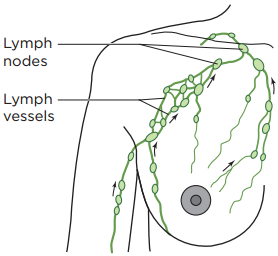Understanding Breast Cancer” Related” Lymphedema:

Introduction
Welcome to the essential guide on Breast Cancer–Cancer-related lymphedema, where we shed light on a crucial aspect of breast cancer treatment and management. Breast cancer–related lymphedema occurs when lymph fluid builds up in the arms or chest after surgery or radiation therapy for breast cancer. It’s vital to understand and manage this condition as it can cause discomfort, swelling, and other complications that affect a patient’s quality of life. By gaining insights into the causes, symptoms, and treatment options for lymphedema, healthcare providers and patients alike can work together to minimize its impact and promote better outcomes during the breast cancer journey. Join us as we navigate through this important topic, empowering individuals with knowledge and resources to navigate their breast cancer treatment journey more effectively.
Causes of Breast Cancer–Related Lymphedema
Explore the underlying causes behind Breast Cancer–Cancer-related lymphedema, a condition that warrants close attention in the breast cancer treatment landscape. Understanding how breast cancer treatment can trigger lymphedema is crucial for both patients and healthcare providers. Surgical procedures and radiation therapy may disrupt the lymphatic system’s normal functioning, leading to fluid buildup and swelling in the affected area. Moreover, certain risk factors heighten the likelihood of developing lymphedema post-breast cancer treatment. By delving into these factors, we equip individuals with the knowledge needed to identify potential risks and take proactive measures to mitigate them. Join us as we unravel the complexities surrounding the causes of Breast Cancer–Cancer-related lymphedema, empowering individuals to navigate their breast cancer journey with greater awareness and confidence.
Symptoms and Diagnosis
Dive into the realm of Symptoms and Diagnosis of Breast Cancer–Cancer-related lymphedema, where we illuminate the signs and diagnostic methods crucial for early detection and management. Recognizing common symptoms such as swelling, heaviness, and discomfort in the arms or chest can serve as early warning signs of lymphedema in breast cancer patients. Equally important is understanding the diagnostic techniques utilized by healthcare professionals to confirm lymphedema diagnosis accurately. From circumference measurements and imaging tests to lymphoscintigraphy, a comprehensive approach ensures timely intervention and optimal outcomes. By familiarizing ourselves with these symptoms and diagnostic methods, we empower individuals with the tools needed to navigate their breast cancer journey with vigilance and confidence, promoting better health and well-being along the way.
Management and Treatment Options
Embark on a journey through the realm of Management and Treatment Options for Breast Cancer–Cancer-related lymphedema, where we explore various strategies aimed at alleviating symptoms and improving quality of life. Conservative management techniques form the cornerstone of lymphedema treatment, encompassing measures such as manual lymphatic drainage, compression therapy, exercise, and skincare. These non-invasive approaches are often effective in reducing swelling and enhancing lymphatic function. However, in cases of severe lymphedema, surgical and medical interventions may be necessary. Surgical procedures like lymphatic venous anastomosis or vascularized lymph node transfer, along with medical interventions such as lymphatic pump therapy, offer promising avenues for managing advanced lymphedema cases. By providing a comprehensive overview of these management and treatment options, we empower individuals with the knowledge needed to make informed decisions and achieve optimal outcomes in their battle against breast cancer–related lymphedema.
Lifestyle Tips and Support Resources
Discover essential Lifestyle Tips and Support Resources designed to empower individuals navigating the challenges of breast cancer–related lymphedema. Lifestyle modifications play a pivotal role in preventing and managing lymphedema symptoms, encompassing practices such as maintaining a healthy weight, practicing gentle exercises, avoiding injury, and practicing good skincare habits. By incorporating these lifestyle changes into daily routines, individuals can minimize the risk of lymphedema flare-ups and optimize their overall well-being. Additionally, a robust network of support resources and organizations exists to provide guidance, encouragement, and assistance to breast cancer patients grappling with lymphedema. From online forums and support groups to dedicated organizations offering education and advocacy, these resources offer invaluable assistance in navigating the complexities of lymphedema management and finding solidarity within a supportive community. Join us as we explore these lifestyle tips and support resources, empowering individuals to thrive amidst their breast cancer journey.
Conclusion
In conclusion, it’s crucial to remember key points about breast cancer–related lymphedema. First, understanding that lymphedema can occur after breast cancer treatment due to damage to the lymphatic system is essential. Common symptoms include swelling, heaviness, and discomfort in the arms or chest, so it’s important to stay vigilant. Diagnosing lymphedema involves measurements and tests by healthcare professionals to confirm the condition accurately.
Early detection, management, and support are vital for patients with breast cancer–related lymphedema. By detecting lymphedema early, individuals can start conservative management techniques like compression therapy and exercise to alleviate symptoms and prevent progression. Additionally, lifestyle modifications such as maintaining a healthy weight and practicing good skincare habits can significantly improve quality of life.
Moreover, support resources and organizations play a crucial role in providing guidance, encouragement, and assistance to individuals dealing with lymphedema. These resources offer a sense of community and understanding, empowering patients to navigate their journey with confidence and resilience.
In summary, early detection, effective management, and strong support systems are paramount for individuals with breast cancer–related lymphedema. By staying informed, proactive, and supported, patients can lead fulfilling lives despite the challenges posed by this condition.penguintalks.com





